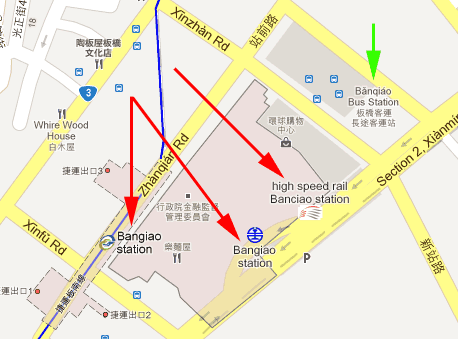What on earth is going on over at Google?
Just last week I had nothing but love for Google Maps because it had finally made some important improvements to its maps of Taiwan. But just a few days later Google went and screwed up its maps again. The names of most of Taipei’s MRT stations are now written incorrectly. In most cases, this is merely a matter of form, with capitalization — and the important designation of MRT — missing. But in more than just a few instances some astonishing typos have been introduced. What’s especially puzzling and irksome about this is that in most of these cases Google Maps swapped good information for bad.
Meow tipped me off in a comment yesterday that “In Google Maps, Jiannan Rd. Station and Gangqian Station become Jianan road station and Ganggian station.”
Here’s a screenshot taken today of some MRT stations in Dazhi and Neihu:

As Meow said, Jiannan is written Jianan, and Gangqian is written Ganggian. What’s more, Dazhi is written Dachi, and Xihu is written His-Hu (Cupertino effect?).
There are now many such errors.
Here’s a screenshot taken last week.

And here’s the same place today.

As you can see, one of the instances of Jieyunsongjiangnanjing has been removed, which is good. But that’s the end of the good news. Another Jieyunsongjiangnanjing remains. And the one that was removed was replaced by Songjian nanjing station, with Songjiang misspelled and Nanjing and Station erroneously in lower case. And “MRT” is missing too.
It’s not just the station name that was changed, as the switch of one location from the Thai tourism office to the Panamanian embassy shows. (Perhaps both are in the same building.)
Here are some more examples of recently introduced errors.
The westernmost station on the blue line is now labeled Tongning. The pain! The pain! It should be Yongning, which is also visible.

In perhaps the oddest example, Qili’an, which has been miswritten Qilian for years, has been redesignated Chlian.

Above we saw Gangqian written incorrectly as Ganggian and Minquan written incorrectly as Minguan. Here’s another example of a q being turned into a g: Banqiao has become Bangiao. Even the train station, which is a different rail system than the MRT, has been affected. But the High Speed Rail Station name remains in Tongyong Pinyin, which I most certainly disapprove of but which at least represents the current state of signage in the HSR system.

Sloppy work, Google. Very sloppy. How could this have happened?




Many of these latest changes look like OCR errors to me: T replacing Y, g replacing q. It would be interesting to know where Google gets its information from. Are they scanning old paper maps? I think I’ve said in the past, it’s clear they have multiple sources and use algorithms to decide which is the best to use for a particular location. Although I rarely find spelling errors, I am increasingly noticing incorrectly-placed labels on Google maps for other countries, for example a building or organisation being shown in the wrong place. It makes me wonder if some of them are user-contributed, or made by scanning unverified websites.
Xihu Branch (????) becomes His-Hu Branch (????). LOL
Google is an entirely machine-learning driven company. Their corporate culture simply does not allow them to generate any data that has to be entered manually by paid employees. They would rather pay a dozen engineers $200k a year, than 60 data-entry people $40k a year.
Some day, this “We’re smarter than you” attitude is going to be Google’s downfall. Might be in 10 years, might be 50. For now, they’re printing money.
Don’t computer people know about GIGO anymore? If Google is indeed using OCR’d scans of printed sources (which could explain the problems) then garbage is indeed what they would be getting … and passing along to everyone.
Like I said, it’s a matter of corporate culture.
Peter Norvig — the guy who wrote *the* artificial intelligence textbook, and got a bunch of press for teaching a 60,000-student online course — is a big honcho at Google.
Therefore, Google insists on using machine learning for all sorts of things, even when other approaches might work better (they especially look down upon low-tech approaches, such as having trained people type in the street names).
I dont have any specific knowledge about the culture at Google, but the ‘techy’ in me can see that sticking with machine learning is really the only practical way forward for them.
By insisting on this approach, it means that problems will HAVE to be solved in some way, so their engineers will work on getting the algorithms better and better. Whereas relying on manual input (which is also prone to error) just means they will have an ever growing payroll as more ‘difficult to read’ things need to be input into the system. Relying on manual input doesnt force them to push the boundaries of what machine learning can do. Without this way of thinking, it would be too tempting to just throw more typists at a problem, which doesn’t offer any benefit for the future. So, it makes complete sense for them to spend $200k each on engineers, rather than $40k each on loads of typists.
Is OpenStreetmap any better?
See also http://ogleearth.com/2012/01/google-conspiring-for-regime-change-in-syria-through-maps-hardly/